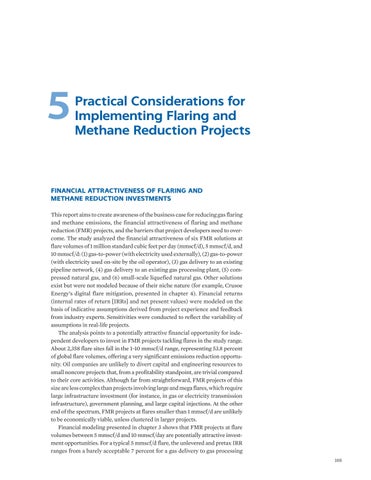5
Practical Considerations for Implementing Flaring and Methane Reduction Projects
FINANCIAL ATTRACTIVENESS OF FLARING AND METHANE REDUCTION INVESTMENTS This report aims to create awareness of the business case for reducing gas flaring and methane emissions, the financial attractiveness of flaring and methane reduction (FMR) projects, and the barriers that project developers need to overcome. The study analyzed the financial attractiveness of six FMR solutions at flare volumes of 1 million standard cubic feet per day (mmscf/d), 5 mmscf/d, and 10 mmscf/d: (1) gas-to-power (with electricity used externally), (2) gas-to-power (with electricity used on-site by the oil operator), (3) gas delivery to an existing pipeline network, (4) gas delivery to an existing gas processing plant, (5) compressed natural gas, and (6) small-scale liquefied natural gas. Other solutions exist but were not modeled because of their niche nature (for example, Crusoe Energy’s digital flare mitigation, presented in chapter 4). Financial returns (internal rates of return [IRRs] and net present values) were modeled on the basis of indicative assumptions derived from project experience and feedback from industry experts. Sensitivities were conducted to reflect the variability of assumptions in real-life projects. The analysis points to a potentially attractive financial opportunity for independent developers to invest in FMR projects tackling flares in the study range. About 2,358 flare sites fall in the 1–10 mmscf/d range, representing 53.8 percent of global flare volumes, offering a very significant emissions reduction opportunity. Oil companies are unlikely to divert capital and engineering resources to small noncore projects that, from a profitability standpoint, are trivial compared to their core activities. Although far from straightforward, FMR projects of this size are less complex than projects involving large and mega flares, which require large infrastructure investment (for instance, in gas or electricity transmission infrastructure), government planning, and large capital injections. At the other end of the spectrum, FMR projects at flares smaller than 1 mmscf/d are unlikely to be economically viable, unless clustered in larger projects. Financial modeling presented in chapter 3 shows that FMR projects at flare volumes between 5 mmscf/d and 10 mmscf/day are potentially attractive investment opportunities. For a typical 5 mmscf/d flare, the unlevered and pretax IRR ranges from a barely acceptable 7 percent for a gas delivery to gas processing 105


